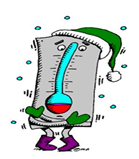July temperature shock: The great ‘polar vortex’ debate?
July 15 marks mid-summer in Minnesota and the northern hemisphere. Weather folk should be babbling about heat index, dew point and the latest tally of steamy 90 degree days.
Hotter than the 4th of July? Not this summer.

Instead a somewhat heated debate has broken out in meteorological circles about what to call the record July cold snap swirling into the Upper Midwest today. Yes, weather and baseball fans, Minnesota is the epicenter once again for an arctic outbreak. But this time it's happening in mid-July.
Polar vortex?
Create a More Connected Minnesota
MPR News is your trusted resource for the news you need. With your support, MPR News brings accessible, courageous journalism and authentic conversation to everyone - free of paywalls and barriers. Your gift makes a difference.
This forecaster thinks that's an apt description for the frigid All-Star onslaught underway given the origin and trajectory of the incoming upper level vortex.
But some in the weather community beg to differ. What's that old saying? Something about 10 different meteorologists in one room and 10 different forecasts?
Welcome to the Brotherhood of Weather. How about those MLB All-Stars?
65 degrees 24-hour maximum temperature at Minneapolis-St. Paul International Airport Monday July 14 (average high for Oct. 1)
Coldest July 14 on record (previous record was 68 degrees set in 1884)
84 degrees average high for July 14 in the Twin Cities
-19 degrees vs. average

The cold facts
Do not adjust your television set. This is not a drill. It is still mid-July. This is Minnesota, Land of 10,000 Weather Possibilities.
Here's a look at an almost unbelievable weather map from 5 p.m. July 14, as fleece-lined fans file into the MLB All-Star Home Run Derby at Target Field.
Yes, that's a temperature of 59 degrees with a raw rainy northwest wind gusting to 35 mph at MSP Airport at 5 p.m.

Tonight will likely be the coldest night in July. Temperatures in the 40s are likely as close as the Twin Cities suburbs. I won't be shocked to hear some spotty frost reports from the colder nooks and crannies in northeast Minnesota Tuesday morning. Way too much blue on the maps for mid-July.

Forecast: Improving
Monday was the day people will be taking about 10 years from now. By Tuesday afternoon, the July sun warms and temps mellow. Here's a look at the rest of the week, which will arguably be one of the finest in Minnesota this year. Data from the National Oceanic and Atmospheric Administration's Global Forecast System model and Weatherspark.

Polar vortex debate
There's been some consternation in meteorological circles this week about the use of the phrase "polar vortex" to describe this record July cold snap.
As I said last week, I am firmly in the camp with meteorologists like capital Weather Gang's Jason Samenow who view polar vortex as a proper term to describe the source region and trajectory of this unusual air mass invasion into the Lower 48.
Let's talk about the term polar vortex for a minute. Vortex means spinning. In this case an upper level low pressure system. No debate about that. But is it polar?
If you look back at the origin of this particular upper low, there is little doubt that it was near the North Pole a few days ago. It may have phased (merged) with another weaker North Pacific upper low, but the "polar" trajectory is clear.
Here's a great look back the the atmospheric path of this low from Capital Weather Gang and Weatherbell. Watch as "X" marks the spot as the vortex dives south right toward Minnesota and Lake Superior.

Here's more from the Capital Weather Gang's Jason Samenow.
But, in reality, this is a textbook case of polar vortex influence on mid-latitude weather and, frankly, the reasoning of these polar vortex doubters is flawed. I’ll explain why using three graphics.
Some, including the National Weather Service Weather Prediction Center, have claimed the air mass spilling into the U.S. isn’t polar in origin, but rather has its roots from the northeast Pacific.
Link: Weather Service walks away from polar vortex claim (but not chilly forecast)
That’s only half right, as the animation below (above) makes abundantly clear:
Two deep pools of cold air at high altitudes -- yes, one from the northeast Pacific but also one from high in the Arctic -- combined over Canada to generate this cold air outbreak. You can plainly see the evolution of these cold pools, as marked with “x”s above.
To see the polar origins of this air mass even more clearly, consider this graphic showing the air mass trajectory (i.e. where the air is coming from) posted on Slate.com by meteorologist Eric Holthaus.
Here's the Holthaus trajectory tweet. Note the track of this vortex -- from the polar regions.
The bottom line for this forecaster is that the term polar vortex applies here.
The reality on the ground is you may not care. It's mid-July. It's Minnesota. And it's cold outside.
Record cold.